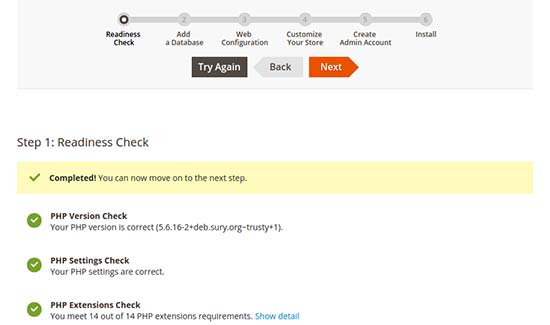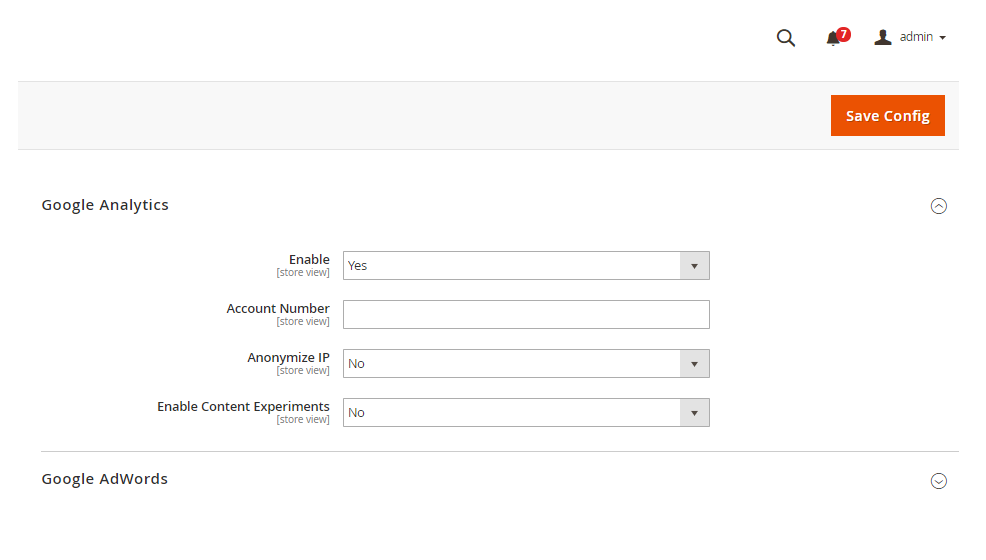OpenCart
Just like WordPress and Joomla, OpenCart is also a CMS and one of the most popular lightweight and fast-growing eCommerce platforms for creating small or medium size eCommerce stores.
OpenCart developed in 1998 is a free open source PHP-based e-commerce platform.
Magento
Currently, owned by Adobe, Magento is the most popular standalone e-commerce platform tailored for large companies.
The feature set of Magento is robust which is ideal for large as well as small companies. Magento offers Community Edition for free, Enterprise Edition is the advanced and paid version of Magento, and the third one is Magento Enterprise Cloud Edition.
Planning to switch to the Magento platform from your existing OpenCart platform? Or planning to start your online business?
Before doing so want facts to review your decision once? Yes, we do understand the pain of choosing the right e-commerce platform for your website. So let’s have a comparative journey through the capabilities and features of Magento and OpenCart.
What can each platform offer?
Community Support:
Magento and Opencart are the most reliable solutions, however, their state of adequacy is certainly not similar. Like many people have a notion Opencart is much easier to use than Magento.
It is just because the feature set and capabilities offered by Magento are quite wide.
Both have huge and well-established developer community support. However, the Magento developer community is much robust than any.
Since you can easily find professionals experienced in the development of Magento. This gives more freedom to mold the platform functionalities the way want to meet your business needs.
http://magento.stackexchange.com/
https://community.magento.com/
You think of an add-on and you will find it in their respective marketplace.
https://marketplace.magento.com/
https://www.opencart.com/index.php?route=marketplace/extension
Below is the screenshot from Google Trend depicting the shopping cart popularity of Magento and OpenCart. Both the platforms are quite popular and closely associated in terms of basic functionalities and feature sets.
But still, the search results done for Magento is far high than that of Opencart.
Installation:
Both platforms don’t include any subscription charges as they are fully open source. You just have to download and install it with one click.
Opencart is very easy to install and set up. And when it comes to hosting, OpenCart is cheaper because it is lightweight making it apt for small to medium-size stores. And Magento for medium to large-sized websites.
Magento offers great flexibility and scalability because it is the most dynamic and customizable solution which makes its architecture quite complex requires more hosting resources.
Though Magento requires more resources compared to OpenCart, it doesn’t make Magento any less than that of OpenCart.
It is always advised that Magento should be hosted on a strong and dedicated server. Because running Magento on shared hosting will result in a slow and frustrating user experience.
You can easily find installation tutorials and documentation online if encounters any issue while installing the module.
Analytics:
Google Analytics is one of the best analytic tools that offer deep insights into website traffic and sales. As OpenCart offers Google Analytics as its default feature you can enable it by feeding your Google Analytics tracking code.
By default, Magento also supports basic tracking needs like page view tracking of your e-commerce visitors and the sales. You don’t require to integrate any analytic extension to your online store.
For this, you only need to provide the Google Analytics Account Id in your Magento.
Security:
With OpenCart, you won’t find any major security holes but comparatively, Magento grabs a win. All Magento versions are PCI-compliant taking security a prime concern.
Magento offers patches and the most advanced built-in security features ground to top sell products online because it’s dedicatedly developed for e-commerce tasks.
Magento patches are small changes/updates made to the code for providing security protection. That’s why patches are the most recommended updates.
With growing business needs you’ll surely require additional plugins. But extensions could be the most vulnerable part of your e-commerce site.
Because extensions are not updated regularly which makes them vulnerable, the time before a patch is released. Therefore, it is advised to always go for the popular extensions with frequent updates.
Performance:
Website performance and speed have always been the prime concern of every website owner. Because low performance lets customers experience slow page loads causing potential customers to leave the website before they even get on to the checkout page.
Magento supports almost all the cache handlers/ performance tools. Opencart too supports cache handlers/ performance tools but in comparison to Magento, it is less.
In Opencart there are only three caching adapters —file, Memcache, and APC.
While Magento is using modern technologies like Memcached, Redis, Varnish support, FPC, Static Code generation, DI command-line utility, etc tailored for achieving high-performance needs.
Also, Magento 2 supports Php7 with full page cache and this lacks in OpenCart.
OpenaCart does not ensure high performance unless you opt for additional plugins for advanced SEO Optimization, separate Cache Management. While Magento store owners can avail SEO and Cache management feature as an inbuilt functionality like –
- Flush all cache items completely.
- Flush default Magento cache items.
- Flush Javascript and CSS files.
- Flush catalog images cache.
However, website performance also depends upon your server architecture and hosting too. You can host your OpenCart website either using any shared hosting or a dedicated server hosting because Opencart is lightweight and requires fewer resources.
While Magento will not work on shared hosting especially Magento 2 because it requires dedicated server support.
And for the marketplace business model, it’s suggested to opt for scalable hostings like Amazon cloud or Google cloud. Recently Amazon released a cost-effective solution for VPS, Amazon Lightsail – https://amazonlightsail.com/.
Scalability & Flexibility:
One of the greatest advantages of both platforms is their ability to support multiple languages and currencies. When it comes to a large database, OpenCart falls short while Magento keeps going.
Magento enables merchants to go at the highest with highly customizable shopping experiences, adaptive design restraints, and great SEO resources.
Magento offers much-needed features of a web store including products, site design, shipping, payments, and more.
This makes Magento be the most picked e-commerce platform by the merchants who are looking forward to expanding business with a large volume of products, customers, transactions, etc.
Because Magento architecture is highly scalable and lets you support your growing business needs in near future.
Magento also takes a lead in flexibility to extend your business edges. The Magento is based on MVC+MVV based architecture. It offers great control and access over the design, content, and functionality.
Code Structure:
Magento and Opencart both are MVC-based e-commerce platforms but OpenCart is not coded as well as Magento.
Because Magento is a brilliant design paradigm embedded with major open source technologies like RequireJS / Knockout.js, composer, symfony2, code standards PSR, dependency standards, etc.
Magento is based on a composer with TDD (Test Driven Development )technique. The composer is a dependency management tool. And TDD is based on Magento Testing Framework(MTF).
It is an automated testing suite that comprises performance, functional, and unit testing. One can go through the entire MTF by visiting the https://github.com/magento/mtf project.
Opencart too includes composer https://github.com/opencart in its latest releases. But not as feature-loaded as Magento.
However, Magento provides out-of-the-box hooks/events to extend the functionalities for customizing the Magento. That’s why you can customize the Magento without making changes in core codes. In comparison, Opencart provides fewer events to extend the functionality.
Intuitive API:
Magento by default provides web services API in REST and SOAP format. Whereas Opencart provides the web services only in the REST format.
SEO Resources:
There is no doubt OpenCart is a bit restrained and basic when it comes to SEO(search engine optimization) standards. It doesn’t even support the admin custom URL.
On the other hand, SEO features like SEO-friendly URLs, Meta-information for products and categories, Google Sitemaps, URL rewrites, Description, etc make Magento a powered SEO-enabled platform.
It enables users to have complete control over SEO settings like search-friendly URLs, content, and tagging.
Which platform is more feature-loaded?
There are various inbuilt features you won’t find in the OpenCart store but surely in Magento store like –
- Product Types: OpenCart supports simple and downloadable product types only. While Magento supports a wide range of types of products.
- Tier Pricing tends to offer a quantity discount to the specified customer groups.
- The category defines the structure of your store catalog. In Magento, one can define the category levels up to”n” levels while in OpenCart, it supports up to 3 levels.
- Cart Price Rules are the price rules applied to the cart’s total amount value.
- Catalog Price Rules are the price rules applied to the product added to the shopping cart.
- Layered Navigation provides efficient and easy-to-use product filters for store visitors.
- Using a single instance, one can create Multi-Website in Magento. While OpenCart doesn’t support multi-website.
- A Credit Memo is a record that shows the due amount of the customer for a full or partial refund.
- In Magento, one can add a Product Video while in Open Cart there is no such feature.
- An attribute defines the character and property of the product. In Magento, there are product attributes to outline the product type while in OpenCart there is no such thing.
- Rating types: In Magento, one can create rating types like price, quality, experience for the customer to review the product. While in OpenCart, there are no such rating types.
If you want to acquire the above-mentioned features in your OpenCart store, you can do so by integrating OpenCart plugins.


















2 comments
Thanks for the appreciation. If you have any doubt or query then do let us know by mailing us at [email protected]
Regards
Webkul